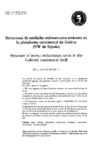Estructuras de unidades sedimentarias recientes en la plataforma continental de Galicia (NW de España)

Ver/Abrir
Use este enlace para citar
http://hdl.handle.net/2183/6013Colecciones
Metadatos
Mostrar el registro completo del ítemTítulo
Estructuras de unidades sedimentarias recientes en la plataforma continental de Galicia (NW de España)Título(s) alternativo(s)
Structure of recent sedimentary units in the Galician continental shelfFecha
1988Cita bibliográfica
Cadernos do Laboratorio Xeolóxico de Laxe, 1988, 12: 35-45 ISSN: 0213-4497
Resumen
[Resumen] Los 'perfiles·· de sísmica de reflexión de alta resolución en la plataforma continental gallega nos permiten conocer la estratigrafía de los sedimentos holocenos.
De techo a muro se distinguen:
- Un nivel superior de limos holocenos marinos con interestratificaciones de arena.
- Un reflector basal que aflora hacia~·ra zona Inedia y externa de la plataforma continental y formado por varias superficies erosionales debidas a lo reducido de los aportes sedimentarios en ese punto.
- Un basamento acústico de naturaleza ígnea y metamórfica con una fuerte respuesta sísmica.
La plataforma se caracteriza por el desarrollo de dos cuerpos de arena limosa que se extiende hacia mar abierto desde la zona interior de plataforma hacia el sur y una superficie de progradaci6n en la zona externa de la plataforma.
El mapa de isopacas demuestra que los sedimentos marinos holocenos forman ... generalmente un lecho contínuo que alcanza su máximo espesor delante de las rías. [Abstract] High-resolution seismic reflection profiles of Galician Continental Shelf show the shallow seismic stratigraphy of Holocene sediments. Three acoustic units can be distinguished from top bottom:
- a continuous upper layer of Holocene marine muds with interstratifications of sand.
- a basal reflector which outcrops towards the middle and outer continental shelf, forming several erosional surfaces due to reduced sediment supply.
- an acoustic basement, of igneous and metarnorphic nature; with strong seismic response.
The shelf is characterized by the development of two bodies of sandy mud that extends offshore from the inner shelf toward the south and a progradation surface on the outer shelf. The isopac map shows that the Holocene marine sediments generally form a continuous layer that reachs a maximum thickness in front of the «rias».
Palabras clave
Galicia
Plataforma continental
Holoceno
Cuaternario
Estratigrafía
Sondeos sísmicos
Galice (Spain)
Continental shelf
Holocene
Quaternary
Stratigraphy
Sismic profiles
Plataforma continental
Holoceno
Cuaternario
Estratigrafía
Sondeos sísmicos
Galice (Spain)
Continental shelf
Holocene
Quaternary
Stratigraphy
Sismic profiles
ISSN
0213-4497





